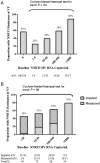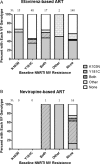Impact of minority nonnucleoside reverse transcriptase inhibitor resistance mutations on resistance genotype after virologic failure
- PMID: 23264671
- PMCID: PMC3571444
- DOI: 10.1093/infdis/jis925
Impact of minority nonnucleoside reverse transcriptase inhibitor resistance mutations on resistance genotype after virologic failure
Abstract
Drug-resistant human immunodeficiency virus type 1 (HIV-1) minority variants increase the risk of virologic failure for first-line nonnucleoside reverse transcriptase inhibitor (NNRTI)-based regimens. We performed a pooled analysis to evaluate the relationship between NNRTI-resistant minority variants and the likelihood and types of resistance mutations detected at virologic failure. In multivariable logistic regression analysis, higher NNRTI minority variant copy numbers, non-white race, and nevirapine use were associated with a higher risk of NNRTI resistance at virologic failure. Among participants on efavirenz, K103N was the most frequently observed resistance mutation at virologic failure regardless of the baseline minority variant. However, the presence of baseline Y181C minority variant was associated with a higher probability of Y181C detection after virologic failure. NNRTI regimen choice and preexisting NNRTI-resistant minority variants were both associated with the probability and type of resistance mutations detected after virologic failure.
Figures


Similar articles
-
Pre-existing minority drug-resistant HIV-1 variants, adherence, and risk of antiretroviral treatment failure.J Infect Dis. 2010 Mar;201(5):662-71. doi: 10.1086/650543. J Infect Dis. 2010. PMID: 20102271 Free PMC article.
-
Resistance patterns selected by nevirapine vs. efavirenz in HIV-infected patients failing first-line antiretroviral treatment: a bayesian analysis.PLoS One. 2011;6(11):e27427. doi: 10.1371/journal.pone.0027427. Epub 2011 Nov 23. PLoS One. 2011. PMID: 22132100 Free PMC article.
-
Low frequency nonnucleoside reverse-transcriptase inhibitor-resistant variants contribute to failure of efavirenz-containing regimens in treatment- experienced patients.J Infect Dis. 2010 Mar;201(5):672-80. doi: 10.1086/650542. J Infect Dis. 2010. PMID: 20102272 Free PMC article.
-
Relationship between minority nonnucleoside reverse transcriptase inhibitor resistance mutations, adherence, and the risk of virologic failure.AIDS. 2012 Jan 14;26(2):185-92. doi: 10.1097/QAD.0b013e32834e9d7d. AIDS. 2012. PMID: 22179227 Free PMC article. Review.
-
Minority HIV-1 drug-resistant mutations and prevention of mother-to-child transmission: perspectives for resource-limited countries.AIDS Rev. 2014 Oct-Dec;16(4):187-98. AIDS Rev. 2014. PMID: 25300623 Review.
Cited by
-
MiDRMpol: A High-Throughput Multiplexed Amplicon Sequencing Workflow to Quantify HIV-1 Drug Resistance Mutations against Protease, Reverse Transcriptase, and Integrase Inhibitors.Viruses. 2019 Aug 30;11(9):806. doi: 10.3390/v11090806. Viruses. 2019. PMID: 31480341 Free PMC article.
-
Contribution of human immunodeficiency virus type 1 minority variants to reduced drug susceptibility in patients on an integrase strand transfer inhibitor-based therapy.PLoS One. 2014 Aug 11;9(8):e104512. doi: 10.1371/journal.pone.0104512. eCollection 2014. PLoS One. 2014. PMID: 25110880 Free PMC article.
-
Multi-Laboratory Comparison of Next-Generation to Sanger-Based Sequencing for HIV-1 Drug Resistance Genotyping.Viruses. 2020 Jun 27;12(7):694. doi: 10.3390/v12070694. Viruses. 2020. PMID: 32605062 Free PMC article.
-
Pretreatment HIV drug resistance spread within transmission clusters in Mexico City.J Antimicrob Chemother. 2020 Mar 1;75(3):656-667. doi: 10.1093/jac/dkz502. J Antimicrob Chemother. 2020. PMID: 31819984 Free PMC article.
-
Low-Frequency Drug Resistance in HIV-Infected Ugandans on Antiretroviral Treatment Is Associated with Regimen Failure.Antimicrob Agents Chemother. 2016 May 23;60(6):3380-97. doi: 10.1128/AAC.00038-16. Print 2016 Jun. Antimicrob Agents Chemother. 2016. PMID: 27001818 Free PMC article.
References
-
- Larder BA, Kohli A, Kellam P, Kemp SD, Kronick M, Henfrey RD. Quantitative detection of HIV-1 drug resistance mutations by automated DNA sequencing. Nature. 1993;365:671–3. - PubMed
-
- Codoner FM, Pou C, Thielen A, et al. Dynamic escape of pre-existing raltegravir-resistant HIV-1 from raltegravir selection pressure. Antiviral Res. 2010;88:281–6. - PubMed
Publication types
MeSH terms
Substances
Grants and funding
LinkOut - more resources
Full Text Sources
Medical

